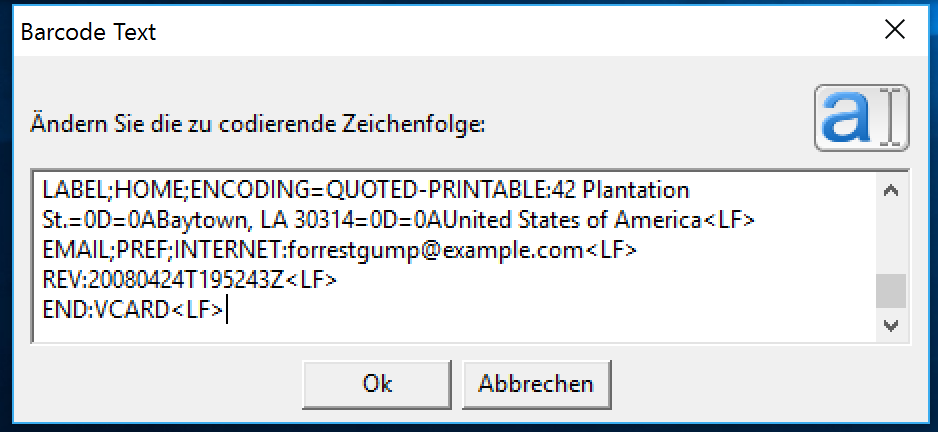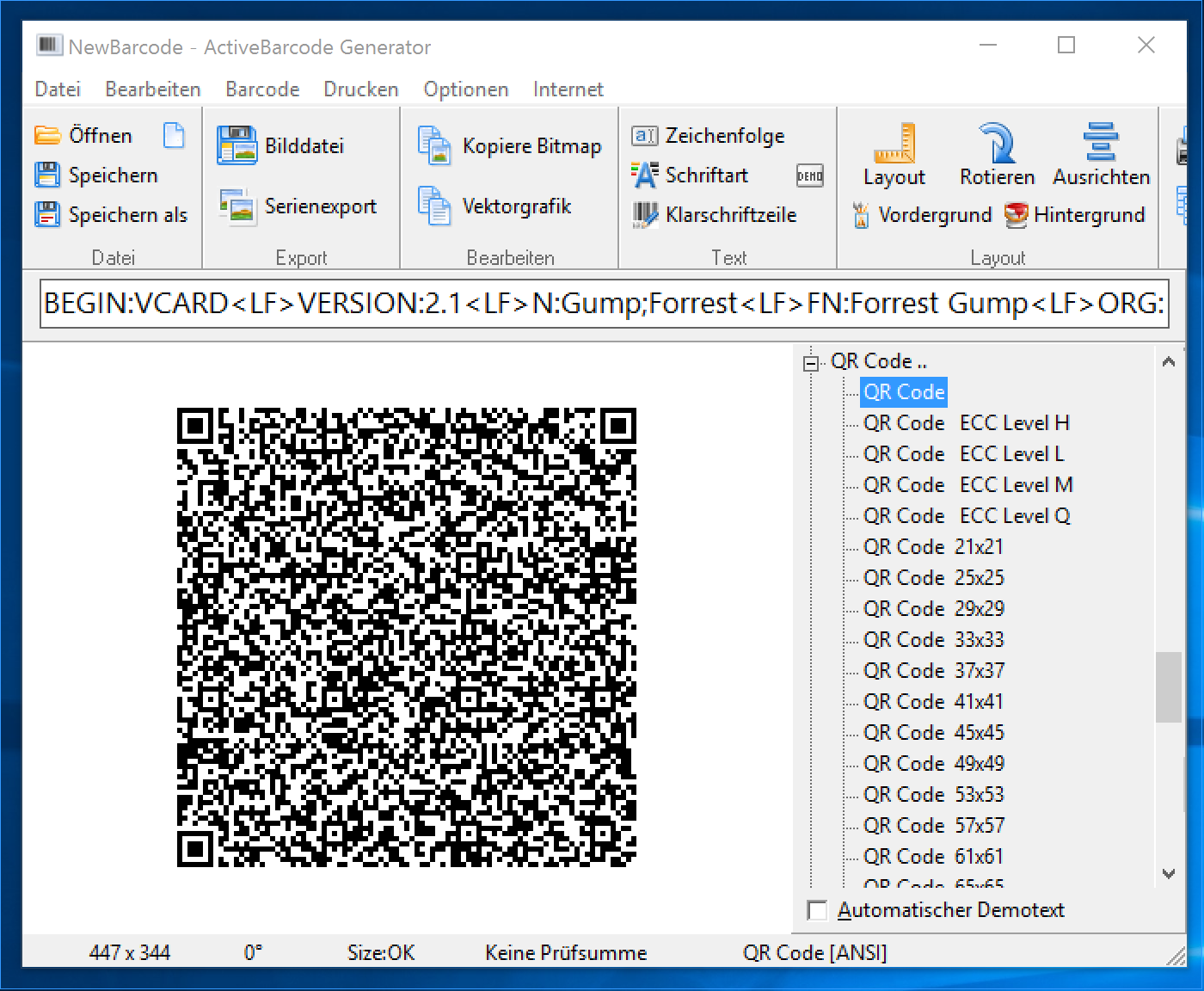Barcode-types FAQ
What are the different types of barcodes and their uses?Link
There are many different types of barcodes, each with its own unique format and structure.
Some of the most common types of barcodes include:
ActiveBarcode supports all common barcode types: A complete list of barcode types can be found here.
- Universal Product Code (UPC): This is the most commonly used barcode in retail settings. It encodes a 12-digit number that identifies the product and its manufacturer.
- Code 39: This barcode is often used in non-retail settings, such as in manufacturing or logistics. It can encode alphanumeric characters and some special characters.
- Code 128: This barcode is similar to Code 39, but it can encode a wider range of characters and is often used in shipping and labeling applications.
- Interleaved 2 of 5 (ITF): This barcode is commonly used in industrial settings, such as in warehouses and on packaging. It encodes numeric data only.
- QR Code:: This barcode is a two-dimensional matrix code that can encode a large amount of data, including text, numbers, and images. It is often used in marketing and advertising applications.
ActiveBarcode supports all common barcode types: A complete list of barcode types can be found here.
Control CharactersLink
How can I use control characters like TAB or CR?
You can use control characters as plain text within angle brackets.
Further information and a list of the control characters can be found here: How to use control characters
Further information and a list of the control characters can be found here: How to use control characters
vCard as a barcodeLink
How to encode a vCard as a barcode?
A vCard can be encoded using the QR Code. We have provided a simple demo for a vCard. If you want to encode a vCard you can use this as a template to start with. This can be done using the generator, the barcode object, the command line tool or the REST API. You can simply copy and paste the multi-line text template into the generator:




Umlaute with Code 128, GS1-128, EAN-128, UCC-128Link
How do I display umlauts with code 128?
The code 128 does not support umlauts by itself. The umlauts are represented, as usual with 7 bit ASCII, by substituting other characters:
ä={
ö=|
ü=}
Ä=[
Ö=\
Ü=]
ß=~
Code 128, GS1-128, EAN-128, UCC-128 Checksum=-1?Link
Is it correct that I always get a -1 for the Checksum property with code 128?
Yes, according to the specification, the codes based on the Code 128 symbology use an internal check digit that is not visible from the outside. This is a different behavior than e.g. with EAN13 where the check digit is always used as the last digit and is then also output as such in the Checksum property.
FNC1 with EAN-128, GS1-128, UCC-128Link
How do I set the FNC1 character that is required for some Application Identifiers?
Select the barcode type EAN/UCC 128 AI. At the point where you need the FNC1, simply enter <FNC1>. ActiveBarcode then automatically encodes this string as FNC1 control character.
If you are using Code 128 or EAN/UCC 128 you can code the FNC1 by using ASCII character <242>.
If you are using Code 128 or EAN/UCC 128 you can code the FNC1 by using ASCII character <242>.
Scan FNC1Link
Why does the scanner return the exact same string whether I use FNC1 or not?
To get the FNC1 control character transmitted from the scanner, the scanner must support this functionality. The FNC1 only has internal meaning and is usually not returned by the scanner. The scanner must therefore offer the option to transmit the FNC1.
Why is there another type with AI for the barcodes GS1-128, EAN-128, UCC-128?Link
What is the difference between the types EAN/UCC 128 and the EAN/UCC 128 AI?
The EAN/UCC 128 converts the entered data 1:1. For example, brackets are always encoded as part of the data in the bar code. However, this is not desired if you want to enter barcodes with Application Identifier (AI).
Therefore, the EAN/UCC 128 AI allows the entry of application identifiers with brackets without coding them. So you can enter AIs as they are displayed: Round brackets are displayed in the human readable text line but not encoded in the barcode.
By entering <FNC1> the control symbol FNC1 is forced which is required when entering variable long AIS.
See also: EAN/UCC 128, GS1-DataMatrix & Application Identifier (AI).
Therefore, the EAN/UCC 128 AI allows the entry of application identifiers with brackets without coding them. So you can enter AIs as they are displayed: Round brackets are displayed in the human readable text line but not encoded in the barcode.
By entering <FNC1> the control symbol FNC1 is forced which is required when entering variable long AIS.
See also: EAN/UCC 128, GS1-DataMatrix & Application Identifier (AI).
Are the round brackets part of the application identifier?Link
Are the brackets of the application identifiers coded as part of the barcode? For example, when (10) is read with the scanner, the brackets are not displayed. Is this correct?
Yes, that's correct and expected behavior. The round brackets are not encoded into the barcode. They serve only to improve readability of the plain text line. The code itself will not contain these round brackets when they are used as application identifiers.
If you use the EAN/UCC 128 AI or GS1-128 code, the brackets are irrelevant. If you want to use them for the readability of the plain text line, just enter them as well: ActiveBarcode does not encode the brackets with this type. It is therefore up to you whether you enter the brackets or not. The barcode itself is always created correctly, whether you use the brackets or not.
See also: EAN/UCC 128, GS1-DataMatrix & Application Identifier (AI).
If you use the EAN/UCC 128 AI or GS1-128 code, the brackets are irrelevant. If you want to use them for the readability of the plain text line, just enter them as well: ActiveBarcode does not encode the brackets with this type. It is therefore up to you whether you enter the brackets or not. The barcode itself is always created correctly, whether you use the brackets or not.
See also: EAN/UCC 128, GS1-DataMatrix & Application Identifier (AI).
Quite zoneLink
I have a barcode on my product and I don't know how much space I need around it.
The quiet zone must be at least 10 times the width of a module. The width of a module corresponds to the narrowest bar (black or white) in a barcode. For example, if the narrowest line is 0.2 mm wide, the quiet zone should be at least 2 mm.
Code 39 Extended & Code 93 ExtendedLink
Why is the barcode getting so wide?
When using the characters from the extended set, the character is made of two symbols in the barcode, which will increase the effective width of the barcode as those require more space. You should increase the width of the barcode, so the maximum code length you require will fit. Or you could choose another barcode type with a higher data density.
Code 39 check digitLink
How can the final check digit added to the Code39 barcode?
Select the barcode type Code 39 Checksum (Type #26) instead of Code 39 (Type #06). The check digit will then be attached automatically.
Code 128, GS1-128, EAN-128, UCC-128 check digitLink
Can I switch off the check digit for Code 128?
The check digit of all barcodes in the Code 128 family is a mandatory part and therefore cannot be switched off.
HIBC CodeLink
How can I create a HIBC code?
The HIBC data structure is symbology independent, all common codes such as Code 39, Code 128 DataMatrix and QR code are suitable. You can therefore create a HIBC code if, for example, you use DataMatrix and prepare the user data according to the HIBC notation.
EAN-2 / EAN-5Link
Why doesn't the scanner read the EAN2 and EAN-5 code?
The EAN2 and EAN-5 is an addon code and can only be read by scanners in connection with EAN-13 or EAN-8 (or the corresponding UPC codes).
Clear text line: EAN-2 / EAN-5Link
Is it possible to set the clear text line below the code for the add-on code?
ActiveBarcode always displays the clear text line at the correct position e.g. above the code for EAN-5 and EAN-2. You can also switch off the text line and output any text at any position you like if you want to diverge from the standard.
EN 797Link
Can I create an EN 797 type barcode with ActiveBarcode?
'EN 797' is the norm of the EAN/UPC code. ActiveBarcode supports this code family with e.g EAN-13, EAN-8, UPC-E, UPC-A.
EN 801Link
Can I create an EN 801 type barcode with ActiveBarcode?
Yes, EN 801 is the Code 25 Interleaved standard.
EAN-TU (Trade Unit)Link
Can I create the barcode used for EAN-TU with ActiveBarcode?
Yes, barcodes for EAN-TU (Trade Unit) is another name for the EAN-14 standard.
The trade unit itself can also be part of a UCC/EAN-128 with the application identifier (01).
The trade unit itself can also be part of a UCC/EAN-128 with the application identifier (01).
ISBNLink
Can we create an ISBN from one of our EAN-13 or could you create this from the number?
No, you cannot simply use an EAN product number as an ISBN product number.
ISBN is an independent system that only uses the EAN-13 symbology when it is displayed as a barcode.
ISBN is an independent system that only uses the EAN-13 symbology when it is displayed as a barcode.
Manufacturer and product numbersLink
I need an official barcodes for my products. Who assigns me the manufacturer and product numbers for my products?
If you want to use a barcodes for your public traded products you will need an unique code. The manufacturer and product numbers, which you can officially use in trade, are assigned internationally by different organizations. On this page we provide you with links to various organizations that issue these numbers.